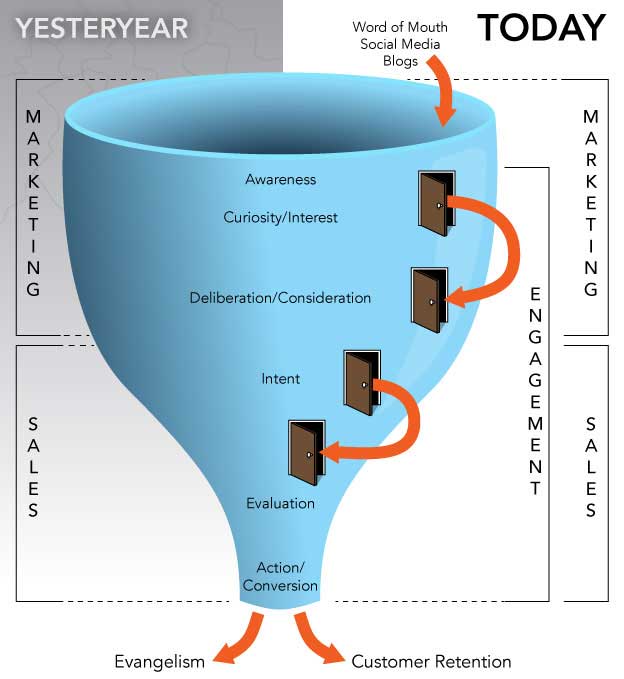There is a lot of talk about the death of the sales funnel, but I disagree. The sales funnel is very much alive; it has, however, evolved.
We are now in the Digital Age. Consumers no longer travel straight down the traditional sales funnel; rather, they come in and out at different stages—sometimes even going silent for months before they come back to purchase.
With such unpredictable buying behaviors, the traditional sales funnel no longer accurately depicts the buying process.
The general stages of the traditional sales funnel haven't changed, but what has changed is the level of influence marketing has at each level. With the consumer's having so much control, Marketing now plays a much larger role in relation to Sales than ever before, making the need for collaboration between the two even more important.
Traditionally, Marketing has been responsible for drawing leads into the funnel, at which point Sales would take over. That no longer works in today's digital environment. Now, marketers are responsible for guiding those leads through the sales funnel until the intent to purchase is clear.
However, marketing doesn't stop there; in fact, marketing never stops. Even once a sale is made, however, both the sales and the marketing teams have the responsibility to ensure that the new client eventually becomes an evangelist and loyal tribe member.
Marketing and sales teams can utilize the modern sales funnel to market more effectively at every stage.

Awareness Stage
At this stage, your potential leads first hear about or come into contact with your brand. They may have heard about you from a referral, social media, Google search, etc. They are simply becoming aware of who you are and what you offer. It is extremely important from the get-go that your messaging be consistent across all channels, including your website, social platforms, and every other customer engagement touchpoint. The more they see you and hear your message, the more aware of your company they become.
Interest Stage
At this point they have come into contact with your brand, whether by word-of-mouth, social media, an ad, or an article. Your messaging has piqued their interest. You have done a solid job of creating a good first impression, and they have now moved to the next stage of the funnel.
At this stage, your consistent messaging, content, website, blog, and more need to be optimized so that leads can easily find out exactly what they want to know about your company.
Tips for keeping them interested:
- Landing pages. Guide your prospects to content-specific landing pages. The more landing pages, the better. Offer free e-books, tips, specials, etc. Landing pages also help with SEO, because their content is more likely to specifically match search queries.
- Interesting and relevant content. Yes, this seems obvious, but you would be surprised how many brands miss the boat when offering content that resonates with their leads. Sales and Marketing need to work together to develop relevant and interesting content ideas that entertain or inform your target market.
Consideration Stage
Your leads have shown interest. They have requested more information via one of your signup forms, requested more information, downloaded an e-book, and maybe even mentioned you on Twitter. At this stage, leads are still not qualified, but they are getting close.
This is one of the most important parts of the funnel. The leads that you have worked so hard to get are now considering your brand as a viable option.
Now is when Marketing must put a lot of effort into guiding leads down through the funnel so they don't want to leave.
Tips at the consideration stage:
- Drip Campaigns. At this stage you really need to show why leads should consider your brand over all others. If they signed up or asked for more information, send it to them. However, mass emails no longer do the trick. Make a point to understand their needs and connect with them on a personal level.
Establishing a trusting relationship is key to any successful sale, so personalize the content they receive. Use an email builder that allows you to incorporate merge fields and dynamic data so that you can automate the personalization of your drip campaigns. Doing so ensures that leads are receiving a series of custom messages persuading them to purchase. - Push them to the edge, not over it. No, I am not talking about a sales offer. I am talking about something that will lead them to take action, suggesting intent to purchase. For example, at the end of your drip campaign, include a call to action that will result in passing them along to Sales.
Intent Stage
Sales loves a lead with a clear intent to purchase. When a lead gets to this stage, a salesperson should have a full tool belt of data about the lead's journey to finish the project and convert.
Marketing has built the foundation, now it's time to start putting up the rest of the building.
Tip for the Intent stage: Develop a real human connection. Even though we are working in a virtual world, we constantly try to humanize our brands. However, nothing compares with the real world; if it did, there would not be the need for a sales team. With a real, human connection, Sales further deepens the relationship Marketing has nurtured. People buy from companies they like—and company is made out of people. So be empathetic and illustrate your understanding of and willingness to solve your lead's challenges.
Action/Conversion Stage
Drum roll, please! What we have all been working so hard for—the sale—has occurred! Marketing has attracted the leads, and Sales has pushed them over the hump! However, the work doesn't just stop once the deal is done. Now you need to work on retaining the customers you just landed. As they say (and it's true), keeping the customers you have is a lot easier (and cheaper) than attracting new ones.
Once you retain new customers, and they eventually begin to actively support your brand, they will have moved toward one of the most important stages—the evangelism stage.
Evangelism Stage
Evangelism is the stage at which your customers are so happy with their customer experience and your brand that they want to share it with their own networks. The result is free marketing—something all of us try to achieve.
This stage is the second most important after the conversion stage, because customer evangelists help you to greatly increase genuine awareness for your brand among audiences.
Tips for creating evangelists:
- Deepen the relationship. So, you got the sale, but that doesn't mean you should just leave your new client high and dry. Consistently schedule follow-ups to make sure the client is happy. You can even offer specials for being a loyal customer.
- Go above and beyond. Put simply, give the customer service experience that you would want to receive. Yep, sounds cheesy, but that's what it comes down to.
- Ask for the mention. Don't be afraid to ask for testimonials, or engagement. If you have done everything right at every other stage, chances are the customer will say yes.
- Continue meaningful communication. Send out monthly newsletters, hold webinars, and send out valuable articles or information. When you do, you are showing that you still have your customer's best interests at heart. You want them to be educated consumers, users, and clients. Add value to their lives, and they will never turn you away.
* * *
So, there you have it. As you can see, the sales funnel has evolved, but in a great way—allowing for collaboration, creativity, and constant communication.
If you are stuck in old ways, why not take a step back to evaluate where the disconnect exists? Often, it's because Sales and Marketing do not share the same goals. That, however, is a topic for another time.




